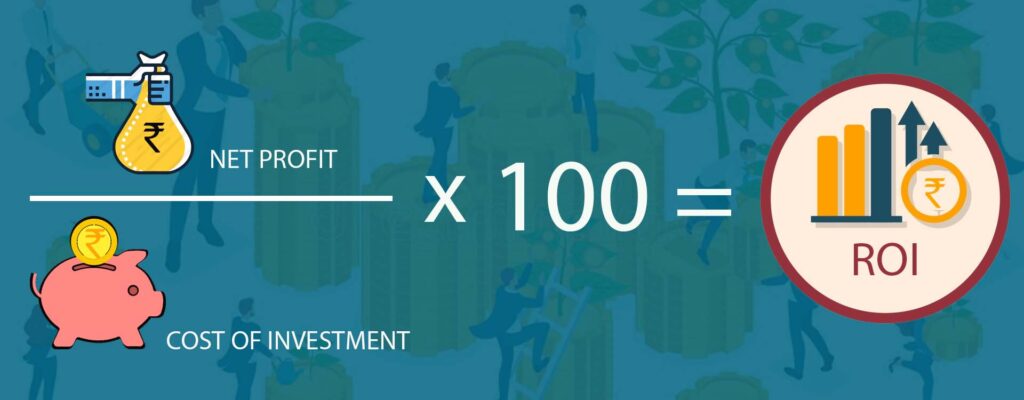Return on Investments, Internal Rate of Return, Net Present Value and other cash flow measures are metrics used to evaluate and rank different investment alternatives based on how attractive each opportunity is. Return on investment (ROI) is popularly used across the business landscape as a metric to measure the probability of gaining a return from an investment.
Although it is a ratio, it’s measured as a percentage that compares the gain or loss from an investment relative to its cost. It is used to measure the probable return from stand-alone investments and comparing returns from different investments.
Return on Investment is used to measure how profitable a stock investment or real estate investment can be and also helps decide whether or not to invest in a particular business. Due to the relative ease of calculating and understanding ROI, it has become a universal measure of profitability in the entrepreneurial world and is used as a set standard measure across countries and companies.
Factors Affecting Return on Investment
Diversified Investment Portfolio:
The overall return of any investment portfolio depends on how diversified the asset mix is. The more the risk, the more the volatility and return potential of the investment portfolio. For instance, stocks are riskier than bonds and thus the rate of return on stocks is more than bonds. But you cannot only invest in stocks as during high volatility, the economy crashes down. When you invest in high-quality bonds, you can have more stable returns that are easy to predict.
Business Strategy:
The business strategies and operations of a business will impact the returns on investment. It depends on how a company optimises on the opportunities they get and deal with market fluctuations and competitions. This will include expansion into new areas, innovating and developing better products, etc. Companies that lose market share and miss earnings expectations almost always underperform the market.
Macroeconomic conditions:
Investment rates of return depend on macroeconomic situations in a country. As more people have jobs, they have more income and tend to spend more. This leads to more sales, profits and investments in terms of capital and resources. Rapid growth leads to higher interest rates making credit more costly and reducing spending and investments. consumer spending and business investments. On the other hand, slowdowns reduce employment, profitability and stock prices. This in turn improves bond prices as investors shift to bonds due to risk averseness.
Fiscal policy:
Policies, regulations and political stability affect investment rates of return. Large fiscal deficits lead to higher borrowing costs for businesses. A stringent regulatory process affects business investments negatively especially in sectors like energy and resources. Political stability leads to investor confidence and increases investment return potentials. Investors will avoid countries with unstable governments or war-prone areas.
‘‘
Although it is a ratio, it's measured as a percentage that compares the gain or loss from an investment relative to its cost. It is used to measure the probable return from stand-alone investments and comparing returns from different investments.

Importance of ROI in business
Closely monitoring the ROI whilst spending wisely is the sign of a smart business that helps them survive in the long run. When you do not see the optimal return on investments in your venture, the smart move is to let it go and invest your funds elsewhere. If you continue to spend it in the same venture, it will lead to losses and debt traps as your business crashes down.
ROI varies with variation in industry. With factors like competition, technological changes and shift in preferences, ROI of industries fluctuate over time. In 2020, technology companies such as Apple Inc. Microsoft Corp. and Amzon.com Inc. generated annual returns well above 10%. On the other hand, energy companies and utilities generated much lower ROIs. Some companies crashed down while some faced losses year-over-year.
What is considered as an optimal ROI?
Return on investment is productive when companies spend money and invest in equipment and capital. Return on investments in terms of sales requires investment in marketing areas. Returns from investing in a new building will have a stark difference from returns from spending on your online marketing like website optimization. Usually, double-digit ROI is healthy during the initial periods of operation and if you get high percentages of ROI then it is always better to optimize and work towards the amplification of such effects. Make smart decisions when it comes to spending money and investing in new areas.
Return on Investment Analysis
Return on Investment analysis is a tool used by analysts to calculate the profitability of any particular investment and also to compare different types of investments. Benefits from an investment are usually called returns as returns can be positive as well as negative whereas profits are only positive. Positive returns on investment mean that investors have gained while in case of negative ROI they incur losses.
ROI analysis can be done in two ways.
By comparing the ROI between periods or companies or with the industry average. For instance, if Company X has an ROI of 20% and Company Y is of the same size as X and works in the same sector having an ROI of 15%, then clearly Company X is better amongst the two.
By breaking down ROI into parts and individually analysing these components. Let’s suppose that the ROI for a company (Net Income/Total Assets) is made up of two components – the asset turnover and the company’s profit margin. Looking at these two components separately, the first part (Income/Sales) shows the net profit margin. The other part (Sales/Total Assets) reflects Asset Turnover. By analysing these two parts individually, you can see which causes an issue with the company’s ROI. This method is also called Dupont.
‘‘
Return on Investment analysis is a tool used by analysts to calculate the profitability of any particular investment and also to compare different types of investments.

Interpreting the Return on Investment (ROI)
ROI is usually represented in percentages in order to make it easier. It includes net return in the numerator as returns can be positive or negative. When ROI calculations give positive results, net returns are in the black as total returns exceed total costs. While on the other hand when ROI calculations yield negative figures, net returns are in the red because total costs exceed total returns or there is a loss. To maintain a high level of accuracy, total returns and total costs should be considered.
Advantages of Return on Investment (ROI)
ROI is easy to calculate and understand making it a standard and universal measure of profitability. It emphasizes on financial gains while calculating returns and ignores social and environmental benefits. ROI analysis helps investors in comparing various investment opportunities.
You can also use ROI to compare returns of current and previous periods to analyse and change your portfolio accordingly. ROI is also used to observe competitiveness in the market. Numbers or parameters required to calculate the ROI are easily available in the financial statements in the traditional accounting system. ROI analysis helps understand pain points and resolve issues quickly. ROIs help set simple targets for both short-term and long-term goals and measure whether or not you are achieving those benchmarks quickly and easily. ROI keeps your company on track by measuring whether your business is profiting above or below its average.
Disadvantages of Return on Investment (ROI)
ROI does not take into account the holding period of an investment which creates issues whilst comparing investment alternatives. A company’s cash flow is not directly reflected in their ROI, so their financial health may not always be measured accurately using ROI alone. Also, ROI only measures the financial success of a project. Investing in new technology may lead to negative ROI but might increase retention rates and happiness levels of employees. ROI does not adjust for risk. However, investment returns have a direct correlation with risk, the more the expected returns, the greater the possible risk.
If an investor considers the only ROI without evaluating associated risk, the eventual outcome of the investment may turn out very differently. ROI figures can be exaggerated if all the expected costs are not included in the calculation. If companies calculate the ROI of all investments without focusing on the value the portfolio or the company is offering, good investment opportunities can be missed.
Predicting ROI may seem like a piece of cake but nobody can see the future. Usually, only a well-thought-out investment will see positive returns. Do not blindly invest without conducting proper research and analysis. To read about more such concepts, check out our articles under DU Academy.




